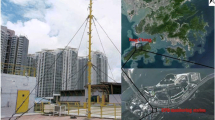Abstract
Atmospheric and laboratory corrosion tests were carried out to assess the intensity of air pollution in East Asia. Qualitative and quantitative atmospheric corrosion was estimated from the damage caused to bronze, copper, steel, marble, cedar, cypress and urushi (Japanese lacquer) plates, exposed to outdoor and indoor airs in some cities of East Asia. Brochantite and cuprite were formed on copper at sites where the sulfur dioxide concentrations were high, and basic cupric nitrate and cuprite at sites where nitrogen dioxide concentrations were high. Gypsum was formed on marble pieces exposed to indoor air at all sites but was not found on pieces exposed to outdoor air. Numerous fine spots (0.2–0.3 mm in diameter) were observed on surfaces of urushi plates exposed at foggy cities such as Chongqing, China and Taejon, Korea. The effects of atmospheric and meteorological factors on the damage to copper and marble plates in several cities in East Asia were estimated using regression analysis. The results indicate that sulfur dioxide is the most destructive of materials especially in China and South Korea. In Japan copper plates may be damaged under natural conditions and by sea salt. Copper may also be damaged by surface deposition of sulfur and chlorine. Marble may be substantially degraded by gaseous sulfur dioxide but sulfate ions in rain had no effect. The analysis of air pollution from the point of view of material damage was very useful in evaluating and visualizing the intensity of air pollution in East Asia.
Similar content being viewed by others
References
Baer, N.S., Bernabo, J.C., Lipfert, F.W. and Smythe, K.D.: 1987, Effects of Acidic Deposition on Materials Degradation, A Synthesis Report, EPRI-EA-5424, Electric Power Research Institute, Palo Alto,CA.
Howell, R.K., Koch, L.P. and Rose, L.P.: 1979, Field Assessment of Air Pollution-induced Soybean Yield Losses, Agronomy Journal, 71, 285–288.
Hutzinger, O. (ed): 1989, The Handbook of Environmental Chemistry, Vol.4B ed., Springer-Verlag, Berlin, pp. 121–146.
Omasa, K.: 1998, Effects of Climate Change on Plants in East Asia, Global Environ. Research, 1, 59–69.
Skoulikidis, T.: 1993, Deterioration and Conservation of Monuments, Proceedings of the 86th Annual Meeting of Air & Waste Management Association, Denver USA, Vol.14, pp. 99–109.
Takamatsu, T., Takada, J., Matsushita, R. and Sase, H.: 2000, Aerosol Elements on Tree Leaves — Antimony as a Possible Indicator of Air Pollution—, Global Environ. Research, 4, 49–60.
Takeuchi, M., Okochi, H. and Igawa, M.: 2000, A Study on Chemical Components and Acidification Mechanism of Dew-Water, J. Japan Soc. Atmospheric Environ., 35, 158–169.
Yonekura, T., Oshima, K., Hattori, M. and Izuta, T.: 2000, Effects of Ozone and Soil Water Stress, Singly and in Combination, on Growth, Yield, Seed Quality and Germination Rate of Soybean Plants, J. Japan Soc. Atmospheric Environ., 35, 36–50.
Author information
Authors and Affiliations
Rights and permissions
About this article
Cite this article
Maeda, Y., Morioka, J., Tsujino, Y. et al. Material Damage Caused by Acidic Air Pollution in East Asia. Water, Air, & Soil Pollution 130, 141–150 (2001). https://doi.org/10.1023/A:1012263822014
Issue Date:
DOI: https://doi.org/10.1023/A:1012263822014




